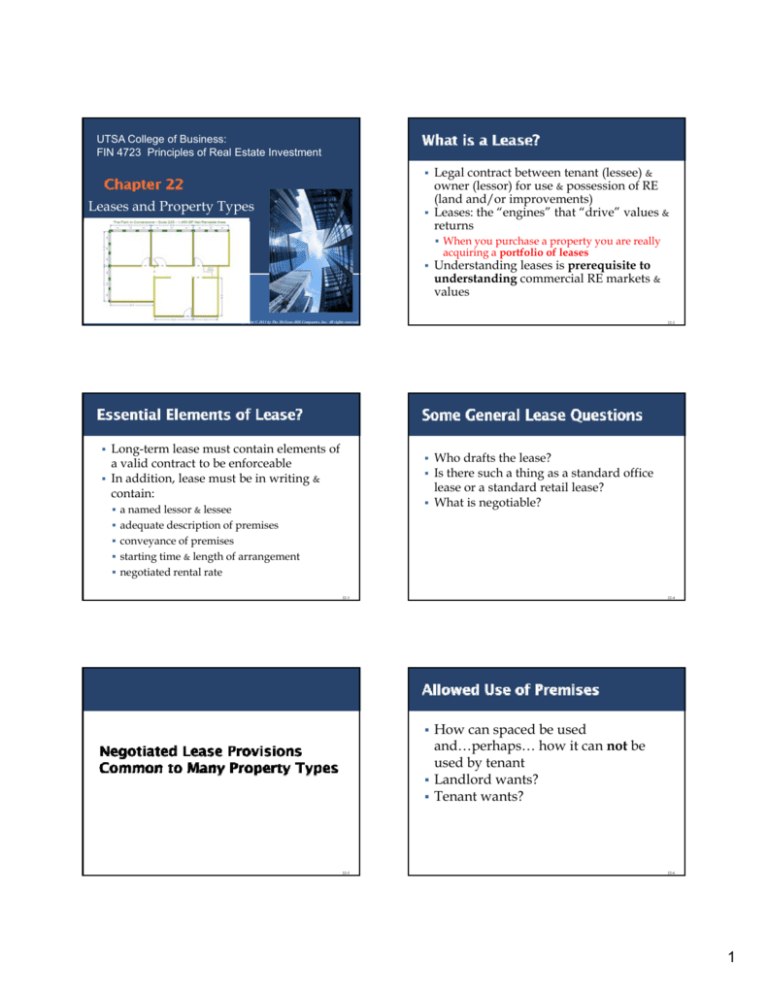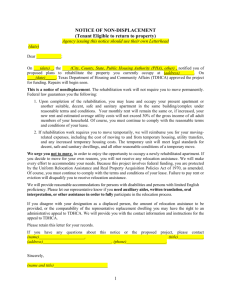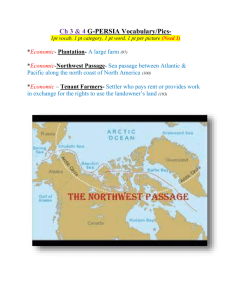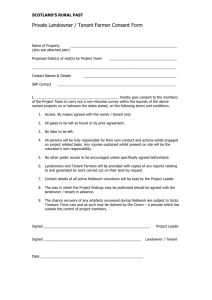
UTSA College of Business:
FIN 4723 Principles of Real Estate Investment
Leases and Property Types
Legal contract between tenant (lessee) &
owner (lessor) for use & possession of RE
(land and/or improvements)
Leases: the “engines” that “drive” values &
returns
When you purchase a property you are really
acquiring a portfolio of leases
McGraw-Hill/Irwin
Understanding leases is prerequisite to
understanding commercial RE markets &
values
Copyright © 2013 by The McGraw-Hill Companies, Inc. All rights reserved.
Long-term lease must contain elements of
a valid contract to be enforceable
In addition, lease must be in writing &
contain:
22-2
a named lessor & lessee
Who drafts the lease?
Is there such a thing as a standard office
lease or a standard retail lease?
What is negotiable?
adequate description of premises
conveyance of premises
starting time & length of arrangement
negotiated rental rate
22-3
22-4
How can spaced be used
and…perhaps… how it can not be
used by tenant
Landlord wants?
Tenant wants?
22-5
22-6
1
One year leases common in residential
In retail office, and industrial properties,
leases may run from 3 years to 20 or more
years
All else equal, longer lease terms:
Flat rent
Graduated/escalated rent
Indexed rent
Rent bumps/escalations are specified in lease
Rent
R
iincreases are tied
i d to, say, the
h CPI
minimize transaction costs
provide rental rate security for tenant & owner
decrease tenant & owner flexibility
22-7
22-8
An important question:
Does landlord or tenant(s) pay operating
expenses?
May depend on whether lease is a
gross,
gross
net,
net-net, or
triple net lease
General definitions but…don’t trust these terms, must
examine the actual clauses in a particular lease
Web Tip
http://www.cfcre.com/glossary.htm
A dictionary of commercial leasing terms
22-9
Expense reimbursement revenue
If tenant is responsible for some of, or all,
operating expenses, according to lease they may:
How are reimbursable expenses allocated
among tenants?
In retail:
Generally prorated based on gross leased area
(GLA) of store as % of GLA of entire center
pay them directly (typical in single-tenant properties)
reimburse landlord (typical in multi-tenant properties)
22-10
Reimbursements show up in investment CF
pro forma as expense reimbursement
revenue
According to BOMA: “computed by measuring from the
building line in the case of street frontages, and from the
inner surface of other outer building walls, and from the
inner surface of corridor and other permanent partitions, and
to the center of partitions that separate the premises from
adjoining shop areas”
in addition to showing up as operating expenses
22-11
22-12
2
How are reimbursable expenses allocated
among tenants?
In office:
prorated based on tenant
tenant’ss rentable area as % of
total rentable area in building
How are reimbursable expenses allocated
among tenants?
In multi-tenant industrial properties:
prorated based on tenant
tenant’ss rentable area as % of
total rentable area in building
Rentable includes tenant's prorata share of common areas
Rentable area includes tenant's exclusive area, plus prorata
share of building common areas
22-13
Rent concessions/abatements
22-14
Including tenant improvement (TI) allowances
Usually requires prior consent of landlord
Landlords want to maintain integrity of building’s
mechanical, electrical, and structural systems
Acceptance of premises
Tenants have specific time period (one week?) to
Landlord may require tenant to restore to
notify landlord (in writing) of any “defects”
Restrictions on alteration or improvements
original configuration & remove trade fixtures
& equipment
Conditions for surrender of premises
“broom clean & in good order & condition”…
“reasonable wear & tear”
22-15
Assignment:
Office properties: common for landlord to
Sublease:
Retail & industrial properties: common for
maintain space
Only a subset of tenant’s rights are transferred
to another party
Responsibility for maintenance of space
All of tenant’s rights & obligations are
transferred to another party
22-16
Property owners can chose to prohibit
assignment & subletting
22-17
tenants to be responsible for their premises;
landlord performs all maintenance outside
tenants’ premises
22-18
3
Use of common areas & facilities (lobbies,
rest rooms, parking lots)
Requirements for obtaining liability
insurance
Advertising and signage
Subordination and non-disturbance
Estoppel certificate
A prospective lender or purchaser of a
Tenant must provide evidence of insurance to
landlord upon request
commercial property will usually require
certificates from tenants stating that the leases
Method for handling late payments &
conditions for surrender of premises
are “in full force & effect” or, if not,
specifying defaults by landlord
22-19
Contract provisions that give holder the
right--but not the obligation--to do
something
Tenant options may include:
22-20
percentage rent
owner has call option on tenant sales
expense stops
lease
l
renewall options
ti
cancellation option
expansion options
owner has put option on expenses
lease cancellation option
Makes lease callable for owner
Including right of first refusal on vacant adjacent space
relocation options
Owner options include:
Effect of tenant options on negotiated base
rent?
Effect of owner options on negotiated base
rent?
22-21
22-22
Option values depend on the uncertainty
of the underlying “state” variable
Examples of underlying state variables:
Contract rental rate often conveys limited
information about lease
p
percentage
g rent:
Calculation of “effective”
effective rental rate
captures monetary aspects of lease
Allows leases to be compared on a more
“apples-to-apples” basis
Also called equivalent level rent (ELR)
either from tenant’s or landlord’s perspective
tenant sales
expense stops:
operating expense levels
renewal option at “old” rental rates:
market rental rates
22-23
22-24
4
Assume 5-Year lease at $20.00 p.s.f. per
year ($1.667 per month) with 18 months
free rent
What is "effective"
effective rent p.s.f.?
Step 1: Calculate PV of lease (LPV) after
concessions
LPV CF1
CF2
CF3
CFT
(1 k )1 (1 k ) 2 (1 k ) (T 1)
Step 2: Calculate equivalent monthly annuity
Step 3: Calculate annual ELR
22-25
Step 1: Calculate PV of lease after concessions
Assume 10% discount rate & beginning of month
payments (i.e. use “BEGIN” mode) (Set Calculator
to P/YR=12)
PV of $1.667 for 60 months = $79.10
PV(N=60, I/YR=10, PMT=$1.667, FV=0)= 79.10
PV of $1.667 for 18 months = $27.98
PV(N=18, I/YR= 10, PMT=1.667, FV= 0) = 27.98
PV of lease with concession:
LPV = $79.10 - $27.98 = $51.12
(or use the CF keys)
Step 3: Calculate annual ELR
ELR = equivalent monthly annuity x 12
= $1.077 x 12
= $12.92
$12 92
22-26
Step 2: Calculate Equivalent Monthly Annuity
Determine monthly fixed payment that has PV
equal to PV of lease with concessions
Monthly annuity of $1.077 for 60 months
has PV of $51.12
PMT(N=60, I/YR=10, PV=51.12, FV=0) = 1.077
Assumption:
2,000 SF rentable area
4-year triple net lease at $18.00 p.s.f. per year
with monthly payments ($1.50 per month)
Permanent Tenant improvements paid by
tenant at lease commencement (that will not
be recovered through TI): $40,000
8% discount rate is appropriate
22-29
What is "effective" rent p.s.f.?
22-30
5
Step 1: Calculate PV of lease including
improvements
8% discount rate & beginning of month payments (i.e. use
“begin” mode)
PV of $3,000
$3 000 ($1.50
($1 50 x 2,000)
2 000) for 48 months
PV(N=48, I/YR=8, PMT=$3,000, FV=0) = $123,705
PV of $40,000 improvements = $40,000
PV of lease with improvements:
LPV = $123,70510 + $40,000 = $163,705
Step 2: Calculate Equivalent Monthly Annuity
Determine monthly fixed payment that has PV equal to
PV of lease with improvements
Monthly annuity/payment of $3,970 for 48
months has PV of $163,705
PMT(N=48, I/YR=8, PV= -163,705, FV=0) = 3970
22-31
Step 3: Calculate annual ELR
22-32
Interlease risk
In ELR calculation, tenant’s discount rate
ELR = (equivalent monthly annuity x 12)/SF
= ($3,970 x 12)/2,000
= $23.82/SF
$23 82/SF
reflects only risk of lease in question
However:
expected tenancy often longer than current lease term,
&
In other words the tenant would be indifferent
between the deal he or she has with you, and
doing uncompensated TI, or with paying $23.82
rent for a space for which no unreimbursed TI is
required.
expected rent pmts beyond existing lease are more
risky than those within a lease
Thus, longer-term leases reduce risk
not reflected in ELR calculation
22-33
Releasing costs
22-34
Releasing costs
Owner & tenant both negatively affected by
Examples:
vacancy period
releasing costs.
Implication:
Both prefer longer lease terms--all else equal
owner loses revenue
search costs
owner pays leasing commissions
both use valuable time
tenant pays moving expenses
owner pays more TI’s
22-35
22-36
6
Flexibility
Tenant’s uncertainty about future space needs
Owner’s desire to alter mix of tenants in a
Consideration
I t l
Interlease
Risk
Ri k
Releasing Costs
Flexibility
dynamic rental market
Implications:
Flexibility considerations suggest shorter term
leases are more valuable to both
Impact on Preferred
Lease Term for
Tenant
Owner
L
Longer
L
Longer
Longer
Longer
Shorter
Shorter
All three are ignored in effective rent calculation
22-37
Class A Properties:
22-38
Class B:
Rents usually less than Class A buildings
Commands highest rents because they are
because of a less desirable location; fewer
amenities; less impressive lobbies, elevators,
etc ($20)
etc.
most prestigious in their tenancy, location, &
overall desirability
y
Usually newer structures
Typically owned by institutional investors
About $25 Quoted rent for San Antonio ($21
is average for all office in SA)
Class C:
Usually once Class A or B
Are older & reasonably well maintained
But are below current standards for one or
more reasons ($16)
22-39
Rentable area:
= gross area - “vertical penetrations”
22-40
Usable area:
Rent generally quoted on rentable area
Tenant’s pro rata share of common area:
= tenant’s usable area / total usable area
= rentable area - common areas
(e.g. conference rooms, lobbies, etc.)
22-41
22-42
7
BOMA standard goes to the inside of
corridor or exterior walls and to center of
walls that separate office spaces
Rentable Area
All the space to
the outside of the
exterior walls,
except vertical
penetrations
Usable Area
Rentable area
less the public
spaces &
ccirculation
cu at o areas
a eas
(common areas)
22-43
Tenant’s
Rentable Area =
sum of
Tenant’s portion
of usable area
Tenant A
+ pro rata share
of common
area
22-44
10 % of total
usable area
Total usable area: 16,000 s.f.
Total common area: 2,000 s.f.
Total rentable area: 18,000
Tenant A’s
A s usable area: 4,000 s.f.
What is tenant A’s rentable area?
22-45
22-46
tenant ' s rentable s. f .
4,000 s. f .
) x 2,000 s. f .
16,000 s. f .
4,000 (0.25) x 2,000
4,000 s. f . 500 s. f .
4,500 s. f .
4,000 s. f . (
Common in office leases
Owner responsible for OE’s up to (“stop”)
amount
stated as amount/SF of total building rentable
space
500 s.f. is the “load factor”
22-47
22-48
8
Per SF expenses beyond stop passed
through based on tenants’ prorata share
of building’s rentable space
Tenants may have different $/s.f. stops
depending on when they signed leases & on
their negotiating position
Assume owner recovers all OE’s from tenant
except management & administrative expenses
Total rentable area is 60,000 s.f.
Total recoverable OE
OE’ss are $350,000
$350 000 (or
$5.83/s.f.) in example year ($350,000/60,000)
Tenant A’s rentable area is 6,200 s.f. & expense
stop is $5.0/s.f.
22-49
Owner recovers $5,146 from tenant A
[$5.83 - $5.00) x 6,200]
A new tenant with a “base-year” stop would have a
$5.83/s.f. stop
22-50
Exhibit 22-5
Total recoverable OE’s in this year are
$350,000 (or $5.83/s.f.)
New tenant’s with base-year stops would
have $5.83/s.f. expense stops
22-51
Neighborhood or “strip” center
Located for convenience of a close-by resident
22-52
Community center
Larger version of a neighborhood center
GLA is usually three times that of a neighborhood
center
Often
Oft anchored
h d by
b a discount
di
t department
d
t
t store
t
May include clothing stores, banks, furniture
population
Contains retail establishments offering mostly
convenience goods (e.g., groceries) & services
(e.g., barber shop, video rental, & dry cleaning)
Often “anchored” by chain grocery store
Gross leasable area of anchor(s) & nonanchored tenant space is approximately 50,000
square feet
Trade area: typically 2-3 mile radius of center
stores, lawn & garden, fast food operations, &
professional offices (e.g., dentists)
Trade area: usually 3-6 mile radius of center.
22-53
22-54
9
Power center
Regional centers:
Dominating feature is high ratio of anchors to
Focused on general merchandise
Usually at least two anchor tenants that are major
Typically contain three or more giants in hard
At least 200
200,000
000 square feet of GLA devoted to
ancillary tenants
department stores (e.g., J.C. Penney’s)
goods retailing (toys, electronics, home
furnishings, etc.)
nonanchor tenants.
Draw people from larger area than neighborhood
or community centers, although 80% of sales are
drawn from within 10-mile radius.
Contain several stores of one type (for example,
shoe stores)
Many include fast-food outlets arranged in food courts
Home Depot & Wal-Mart, etc.
Draw shoppers from a radius of 5 miles or
more
22-55
Super-regional malls:
22-56
May have as many as five or six major tenants
Percentage rent
With clause, total rent = base rent + percentage rent
hundreds of minor tenants.
Typical size is 1 million square feet, but many
exceed
d 2 million
illi square feet
f
off leasable
l
bl area
E.g. Houston Galleria – 5 anchors with 2.4
million square feet, with about 375 stores
(developed by Gerald D. Hines and owned by
Simon Property Group)
&
Example:
Base rent: $$96,000
,
per
p year
y
($
($8,000/mth)
,
/
)
5% of gross sales in excess of $160,000 is paid as percentage
rent
Store produces $200K in monthly gross sales; total rent is
$8,000 + 0.05($200,000-$160,000) = $10,000
Effect of this clause on minimum (base) rent?
22-57
22-58
Tenant usually must provide
monthly sales reports: detailed info on tenant
sales
financial statements upon request
Advertising
Landlords want tenants to advertise
Spend a minimum % of gross sales on advertising
Hard to monitor
Require tenant to advertise in a minimum # of the
shopping center’s advertising tabloids
22-59
22-60
10
Restrictions on operation of tenant’s
business & landlord’s remedies
Grants tenant sole right to sell a specific
Common in retail
Tenant must be open for business during business
hours
off center…or pay additional
h
ddi i
l rent
Exclusive use
product or service in center
Why do landlords dislike this provision?
Cancellation option for tenant
Parking
Landlord requires tenant employees to park in
May be granted if center is struggling to sign
designated areas
Saves “prime” spots for customers
tenants
Co-tenancy provision
Tenant allowed to pay only percentage rent or cancel
if one or more anchor tenants vacate
22-61
22-62
Radius
Prohibits tenant from opening another store
Rents are quoted on basis of gross leasable area
GLA is amount of space occupied & controlled
by tenant
Protects landlord
landlord’ss percentage rent
Gross fl
G
floor area off shopping
h
i center
t iis equall tto
total GLA plus square footage of common areas
Charges in addition to CAM can be security,
advertising, and management of the common
areas.
nearby
Similar to usable area
Signage
Major negotiations often ensue over placement
and size of tenant’s signage
22-63
50,000,000
40,000,000
Gross
20
Note: USAA HQ is
5.3 MM sqft
35,000,000
San Antonio - Ask Rent 2012
25
San Antonio - Square Feet 2012
45,000,000
30,000,000
30 000 000
NNN
15
25,000,000
20,000,000
10
15,000,000
NNN
10,000,000
5
5,000,000
Retail
Office
Industrial
0
65
Retail
Office
Industrial
66
11
2
20,000,000
18,000,000
16,000,000
14,000,000
12,000,000
10,000,000
8,000,000
8 000 000
6,000,000
4,000,000
2,000,000
-
1.8
1.6
1.4
1.2
1
0.8
0.6
0.4
0.2
0
67
68
End of Chapter 22
22-69
12








